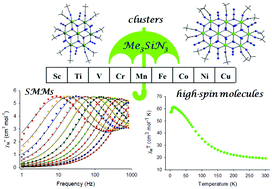Organic chelate-free and azido-rich metal clusters and coordination polymers from the use of Me3SiN3: a new synthetic route to complexes with beautiful structures and diverse magnetic properties
Abstract
In this Feature Article, we highlight the feasibility of a new, recently developed approach towards the synthesis of high-spin molecules and single-molecule magnets (SMMs). The key to the preparation of such molecular compounds is the organic azide precursor Me3SiN3, which fosters the formation of 3d-metal azido clusters and coordination polymers without requiring the assistance of any organic chelating/bridging group. All the isolated compounds contain metallic cores which are surrounded by end-on bridging N3− groups. Consequently, the reported molecular materials exhibit ferromagnetic exchange interactions between the spin carriers, resulting in the stabilization of the maximum possible spin ground states. The additional presence of magnetic anisotropy, depending on the 3d-metal ion used, gives rise to SMM properties with interesting and rare features. This article intends to introduce the readers to an unexplored, but in coordination chemistry very useful azido-based reagent and emphasize the pronounced differences in the structures and magnetic properties of the compounds that result from the reactions between 3d-metals and NaN3 or Me3SiN3 in the presence of organic bridging groups, and 3d-metals with Me3SiN3 alone.



 Please wait while we load your content...
Please wait while we load your content...